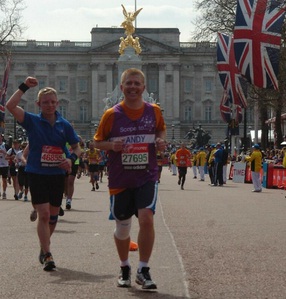Many of you may know that I’ve decided to run the London Marathon this year. I’m running for Scope – inspired partly by last year’s Paralympics and partly by the support they give to disabled people every day. Many of you may also be surprised that I’m running at all. Is it a mid-life crisis? Almost certainly.
Part of my plan is also to create some publicity for sport and sports science expertise amongst GuildHE members. Universities such as Worcester, Leeds Trinity, Southampton Solent, Marjon and Chichester are amongst the UK’s best in these subjects. Did you know for example, that the University of Worcester is about to open the UK’s first purpose built arena for Paralympic sport?
Sport and sports science is a big growth area in UK Higher Education and a massive success story. During the Olympics last year it was calculated that the medal tally for UK universities would have put them third in the table (32 golds compared to 29 for the UK). Health is another important specialism and institutions such as the Anglo European College of Chiropractic and the British School of Osteopathy are also deeply engaged in sport and fitness. The latter has just won a THE award for services in the community – and Charles Hunt, the Principal, has promised me free treatment if I succumb to injury between now and race day.
But so far training is going well – I’m running regular half marathons (usually in Wolves kit) and feeling reasonably fit. So with a level of confidence I recently dropped in to St Mary’s University College in Twickenham for a fitness test. Now St Mary’s know a thing or two about sport – Mo Farah and David Weir are just two of the athletes that train there and like them I was put through my paces in the laboratory by Dr Charlie Pedlar, Head of the St Mary’s Clinic.

Strapped into a mask and with blood taken from my ear lobe every three minutes, it was a quite disorientating experience. Looking at myself in the mirror was much less motivating than being out on open roads or in the countryside. And the diagnosis? Well ok-ish might be a good summary. Charlie – very encouraging and supportive throughout – was a bit more scientific about it…
‘Your VO2max (a key measure of endurance capacity, but also a general marker of cardiovascular health) ism 47 ml/kg/min, which while respectable for the general population, would be on the low side amongst marathon runners. As I said, reductions in body mass due to an increase in training volume will help to increase this. It would be good to see it rise into the 50-60 range.’
So basically I’m still a bit fat – and 26.2 miles is a long way to carry around more gut than is absolutely necessary. My current running plan didn’t sound adequate to Charlie and I’m now stepping up to 3 or 4 runs a week. If that wasn’t enough, my plan and ‘scientific calculation’ of finishing times – like a MOOC, downloaded from the internet – might also have been on the generous side. I’d been aiming for 4.22 but Charlie reckoned something closer to 5 hours might mean ‘that I enjoy the day more’. Nicely put.
I now have a report and training plan – with ‘zones to hit’ (I think the ‘threshold’ is the key one)…

So not to be discouraged I ran a half marathon last weekend and finished in under two hours for the first time. Not that I’m stubborn or anything. But with Charlie’s and St Mary’s expert help I now know that stepping up from 13 to 26 miles is a pretty big deal. The next six weeks will have to involve some quite serious training – and at least 25-30 miles running per week.
Not only that but I may need a more sensible approach to forthcoming higher education events and dinners. Perhaps rather fewer canapés and only one or two glasses of house wine? I’ve just checked – only seven dinners in March and five in April (not including policy launches or evening ‘seminars’). An avalanche is coming…
I’m running the London Marathon on 21st April for Scope – you can sponsor me at https://uk.virginmoneygiving.com/AndyWestwood
Andy Westwood – CEO, GuildHE

